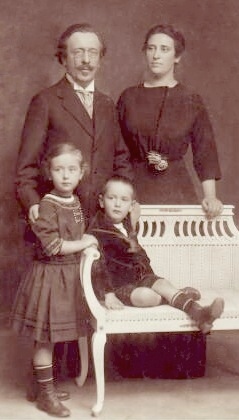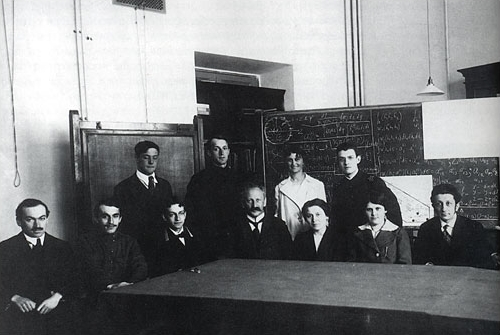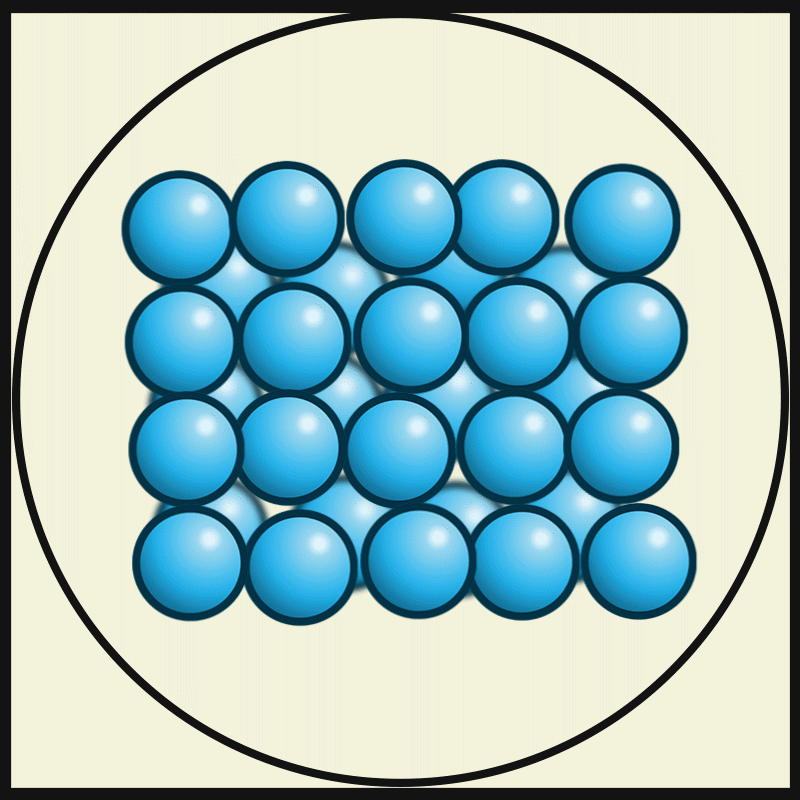|
Superfluidity
Superfluidity is the characteristic property of a fluid with zero viscosity which therefore flows without any loss of kinetic energy. When stirred, a superfluid forms vortices that continue to rotate indefinitely. Superfluidity occurs in two isotopes of helium ( helium-3 and helium-4) when they are liquefied by cooling to cryogenic temperatures. It is also a property of various other exotic states of matter theorized to exist in astrophysics, high-energy physics, and theories of quantum gravity. The theory of superfluidity was developed by Soviet theoretical physicists Lev Landau and Isaak Khalatnikov. Superfluidity often co-occurs with Bose–Einstein condensation, but neither phenomenon is directly related to the other; not all Bose–Einstein condensates can be regarded as superfluids, and not all superfluids are Bose–Einstein condensates. Even when superfluidity and condensation co-occur, their magnitudes are not linked: at low temperature, liquid helium has a lar ... [...More Info...] [...Related Items...] OR: [Wikipedia] [Google] [Baidu] |
Lev Landau
Lev Davidovich Landau (; 22 January 1908 – 1 April 1968) was a Soviet physicist who made fundamental contributions to many areas of theoretical physics. He was considered as one of the last scientists who were universally well-versed and made seminal contributions to all branches of physics. He is credited with laying the foundations of twentieth century condensed matter physics, and is also considered arguably the greatest Soviet theoretical physicist. His accomplishments include the independent co-discovery of the density matrix method in quantum mechanics (alongside John von Neumann), the quantum mechanical theory of diamagnetism, the theory of superfluidity, the theory of second-order phase transitions, invention of order parameter technique, the Ginzburg–Landau theory of superconductivity, the theory of Fermi liquids, the explanation of Landau damping in plasma physics, the Landau pole in quantum electrodynamics, the two-component theory of neutrinos, and Landau's ... [...More Info...] [...Related Items...] OR: [Wikipedia] [Google] [Baidu] |
Isaak Khalatnikov
Isaak Markovich Khalatnikov (, ; 17 October 1919 – 9 January 2021) was a leading Soviet theoretical physicist who made significant contributions to many areas of theoretical physics, including general relativity, quantum field theory, as well as the theory of quantum liquids. He is well known for his role in developing the Landau-Khalatnikov theory of superfluidity and the so-called BKL conjecture in the general theory of relativity. Life and career Isaak Khalatnikov was born into a Ukrainian Jewish family in Yekaterinoslav (now Dnipro, Ukraine) and graduated from Dnipropetrovsk State University with a degree in Physics in 1941. He had been a member of the Communist Party since 1944. He earned his doctorate in 1952. His wife Valentina was the daughter of Revolutionary hero Mykola Shchors. Much of Khalatnikov's research was a collaboration with, or inspired by, Lev Landau, including the ''Landau-Khalatnikov theory'' of superfluidity. During 1969 he briefly worked as a pa ... [...More Info...] [...Related Items...] OR: [Wikipedia] [Google] [Baidu] |
Helium-3
Helium-3 (3He see also helion) is a light, stable isotope of helium with two protons and one neutron. (In contrast, the most common isotope, helium-4, has two protons and two neutrons.) Helium-3 and hydrogen-1 are the only stable nuclides with more protons than neutrons. It was discovered in 1939. Helium-3 atoms are fermionic and become a superfluid at the temperature of 2.491 mK. Helium-3 occurs as a primordial nuclide, escaping from Earth's crust into its atmosphere and into outer space over millions of years. It is also thought to be a natural nucleogenic and cosmogenic nuclide, one produced when lithium is bombarded by natural neutrons, which can be released by spontaneous fission and by nuclear reactions with cosmic rays. Some found in the terrestrial atmosphere is a remnant of atmospheric and underwater nuclear weapons testing. Nuclear fusion using helium-3 has long been viewed as a desirable future energy source. The fusion of two of its atoms would be aneut ... [...More Info...] [...Related Items...] OR: [Wikipedia] [Google] [Baidu] |
Bose–Einstein Condensate
In condensed matter physics, a Bose–Einstein condensate (BEC) is a state of matter that is typically formed when a gas of bosons at very low Density, densities is cooled to temperatures very close to absolute zero#Relation with Bose–Einstein condensate, absolute zero, i.e. . Under such conditions, a large fraction of bosons occupy the lowest quantum state, at which microscopic Quantum mechanics, quantum-mechanical phenomena, particularly wave interference#Quantum interference, wavefunction interference, become apparent Macroscopic quantum phenomena, macroscopically. More generally, condensation refers to the appearance of macroscopic occupation of one or several states: for example, in BCS theory, a superconductor is a condensate of Cooper pairs. As such, condensation can be associated with phase transition, and the macroscopic occupation of the state is the order parameter. Bose–Einstein condensate was first predicted, generally, in 1924–1925 by Albert Einstein, credit ... [...More Info...] [...Related Items...] OR: [Wikipedia] [Google] [Baidu] |
Don Misener
Don Misener (A.D. Misener) (1911–1996) was a physicist. Along with Pyotr Leonidovich Kapitsa and John F. Allen, Misener discovered the superfluid phase of matter in 1937. Misener was a graduate student at the University of Toronto in 1935. He joined Allen at Cambridge University in about 1937. Misener later returned to Canada to work at the University of Western Ontario The University of Western Ontario (UWO; branded as Western University) is a Public university, public research university in London, Ontario, Canada. The main campus is located on of land, surrounded by residential neighbourhoods and the Thame .... Journal references * E. F. Burton, J. O. Wilhelm, and A. D. Misener, ''Trans. Roy. Soc. Can.'' 28(111) p. 65 (1934) * J. F. Allen and A. D. Misener, Flow of Liquid Helium II, ''Nature'' 141(3558) p. 75 (8 Jan 1938) * A. D. Misener, The Specific Heat of Superconducting Mercury, Indium and Thallium, '' Proceedings of the Royal Society of London. Series ... [...More Info...] [...Related Items...] OR: [Wikipedia] [Google] [Baidu] |
Pyotr Kapitsa
Pyotr Leonidovich Kapitsa or Peter Kapitza (, ; – 8 April 1984) was a leading Soviet physicist and Nobel laureate, whose research focused on low-temperature physics. Biography Kapitsa was born in Kronstadt, Russian Empire, to the Bessarabian Leonid Petrovich Kapitsa (), a military engineer who constructed fortifications, and to the Volhynian Olga Ieronimovna Kapitsa, from a noble Polish Stebnicki family. Besides Russian, the Kapitsa family also spoke Romanian. Kapitsa's studies were interrupted by the First World War, in which he served as an ambulance driver for two years on the Polish front. He graduated from the Petrograd Polytechnical Institute in 1918. His wife and two children died in the flu epidemic of 1918–19. He subsequently studied in Britain, working for over ten years with Ernest Rutherford in the Cavendish Laboratory at the University of Cambridge, and founding the influential Kapitza club. He was the first director (1930–34) of the Mond Laborat ... [...More Info...] [...Related Items...] OR: [Wikipedia] [Google] [Baidu] |
Phase Transition
In physics, chemistry, and other related fields like biology, a phase transition (or phase change) is the physical process of transition between one state of a medium and another. Commonly the term is used to refer to changes among the basic State of matter, states of matter: solid, liquid, and gas, and in rare cases, plasma (physics), plasma. A phase of a thermodynamic system and the states of matter have uniform physical property, physical properties. During a phase transition of a given medium, certain properties of the medium change as a result of the change of external conditions, such as temperature or pressure. This can be a discontinuous change; for example, a liquid may become gas upon heating to its boiling point, resulting in an abrupt change in volume. The identification of the external conditions at which a transformation occurs defines the phase transition point. Types of phase transition States of matter Phase transitions commonly refer to when a substance tran ... [...More Info...] [...Related Items...] OR: [Wikipedia] [Google] [Baidu] |
State Of Matter
In physics, a state of matter is one of the distinct forms in which matter can exist. Four states of matter are observable in everyday life: solid, liquid, gas, and Plasma (physics), plasma. Different states are distinguished by the ways the component particles (atoms, molecules, ions and electrons) are arranged, and how they behave collectively. In a solid, the particles are tightly packed and held in fixed positions, giving the material a definite shape and volume. In a liquid, the particles remain close together but can move past one another, allowing the substance to maintain a fixed volume while adapting to the shape of its container. In a gas, the particles are far apart and move freely, allowing the substance to expand and fill both the shape and volume of its container. Plasma is similar to a gas, but it also contains charged particles (ions and free electrons) that move independently and respond to electric and magnetic fields. Beyond the classical states of matter, ... [...More Info...] [...Related Items...] OR: [Wikipedia] [Google] [Baidu] |
Quantum Solvent
A quantum solvent is essentially a superfluid (aka a quantum liquid) used to dissolve another chemical species. Any superfluid can theoretically act as a quantum solvent, but in practice the only viable superfluid medium that can currently be used is helium-4, and it has been successfully accomplished in controlled conditions. Such solvents are currently under investigation for use in spectroscopic techniques in the field of analytical chemistry, due to their superior kinetic properties. Any matter dissolved (or otherwise suspended) in the superfluid will tend to aggregate together in clumps, encapsulated by a 'quantum solvation shell'. Due to the totally frictionless nature of the superfluid medium, the entire object then proceeds to act very much like a nanoscopic ball bearing, allowing effectively complete rotational freedom of the solvated chemical species. A quantum solvation shell consists of a region of non-superfluid helium-4 atoms that surround the molecule(s) and ex ... [...More Info...] [...Related Items...] OR: [Wikipedia] [Google] [Baidu] |
Viscosity
Viscosity is a measure of a fluid's rate-dependent drag (physics), resistance to a change in shape or to movement of its neighboring portions relative to one another. For liquids, it corresponds to the informal concept of ''thickness''; for example, syrup has a higher viscosity than water. Viscosity is defined scientifically as a force multiplied by a time divided by an area. Thus its SI units are newton-seconds per metre squared, or pascal-seconds. Viscosity quantifies the internal friction, frictional force between adjacent layers of fluid that are in relative motion. For instance, when a viscous fluid is forced through a tube, it flows more quickly near the tube's center line than near its walls. Experiments show that some stress (physics), stress (such as a pressure difference between the two ends of the tube) is needed to sustain the flow. This is because a force is required to overcome the friction between the layers of the fluid which are in relative motion. For a tube ... [...More Info...] [...Related Items...] OR: [Wikipedia] [Google] [Baidu] |
Boson
In particle physics, a boson ( ) is a subatomic particle whose spin quantum number has an integer value (0, 1, 2, ...). Bosons form one of the two fundamental classes of subatomic particle, the other being fermions, which have half odd-integer spin (1/2, 3/2, 5/2, ...). Every observed subatomic particle is either a boson or a fermion. Paul Dirac coined the name ''boson'' to commemorate the contribution of Satyendra Nath Bose, an Indian physicist. Some bosons are elementary particles occupying a special role in particle physics, distinct from the role of fermions (which are sometimes described as the constituents of "ordinary matter"). Certain elementary bosons (e.g. gluons) act as force carriers, which give rise to forces between other particles, while one (the Higgs boson) contributes to the phenomenon of mass. Other bosons, such as mesons, are composite particles made up of smaller constituents. Outside the realm of particle physics, multiple identical composite bosons ... [...More Info...] [...Related Items...] OR: [Wikipedia] [Google] [Baidu] |
Phenomenology (physics)
In physics, phenomenology is the application of theoretical physics to experimental data by making quantitative predictions based upon known theories. It is related to the philosophical notion of the same name in that these predictions describe anticipated behaviors for the phenomena in reality. Phenomenology stands in contrast with experimentation in the scientific method, in which the goal of the experiment is to test a scientific hypothesis instead of making predictions. Phenomenology is commonly applied to the field of particle physics, where it forms a bridge between the mathematical models of theoretical physics (such as quantum field theories and theories of the structure of space-time) and the results of the high-energy particle experiments. It is sometimes used in other fields such as in condensed matter physics and plasma physics, when there are no existing theories for the observed experimental data. Applications in particle physics Standard Model consequences W ... [...More Info...] [...Related Items...] OR: [Wikipedia] [Google] [Baidu] |




